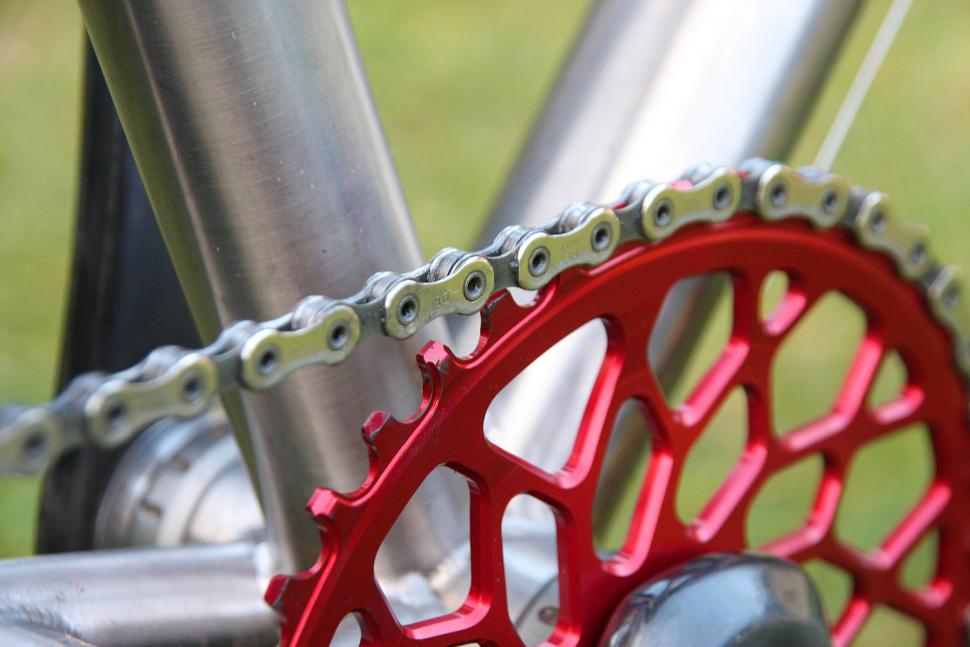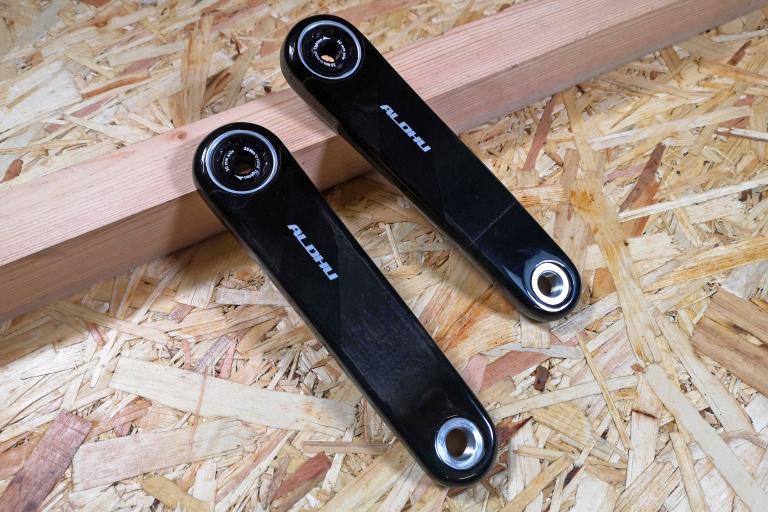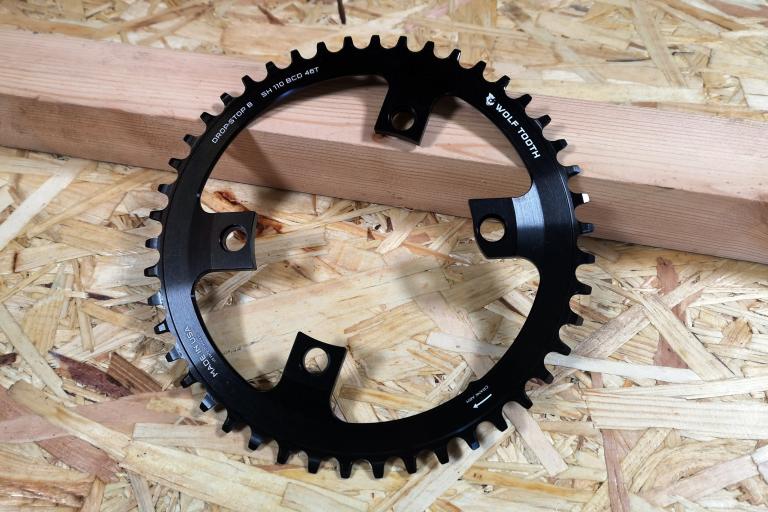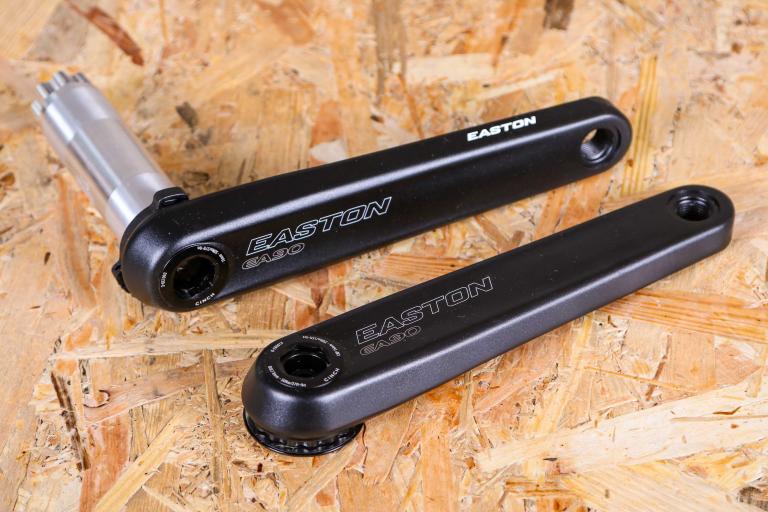- News
- Reviews
- Bikes
- Components
- Bar tape & grips
- Bottom brackets
- Brake & gear cables
- Brake & STI levers
- Brake pads & spares
- Brakes
- Cassettes & freewheels
- Chains
- Chainsets & chainrings
- Derailleurs - front
- Derailleurs - rear
- Forks
- Gear levers & shifters
- Groupsets
- Handlebars & extensions
- Headsets
- Hubs
- Inner tubes
- Pedals
- Quick releases & skewers
- Saddles
- Seatposts
- Stems
- Wheels
- Tyres
- Tubeless valves
- Accessories
- Accessories - misc
- Computer mounts
- Bags
- Bar ends
- Bike bags & cases
- Bottle cages
- Bottles
- Cameras
- Car racks
- Child seats
- Computers
- Glasses
- GPS units
- Helmets
- Lights - front
- Lights - rear
- Lights - sets
- Locks
- Mirrors
- Mudguards
- Racks
- Pumps & CO2 inflators
- Puncture kits
- Reflectives
- Smart watches
- Stands and racks
- Trailers
- Clothing
- Health, fitness and nutrition
- Tools and workshop
- Miscellaneous
- Buyers Guides
- Features
- Forum
- Recommends
- Podcast
review
£57.99
VERDICT:
Oval tech smooths out your pedal stroke (a bit) for a helping hand on the climbs
Weight:
105g
Contact:
At road.cc every product is thoroughly tested for as long as it takes to get a proper insight into how well it works. Our reviewers are experienced cyclists that we trust to be objective. While we strive to ensure that opinions expressed are backed up by facts, reviews are by their nature an informed opinion, not a definitive verdict. We don't intentionally try to break anything (except locks) but we do try to look for weak points in any design. The overall score is not just an average of the other scores: it reflects both a product's function and value – with value determined by how a product compares with items of similar spec, quality, and price.
What the road.cc scores meanGood scores are more common than bad, because fortunately good products are more common than bad.
- Exceptional
- Excellent
- Very Good
- Good
- Quite good
- Average
- Not so good
- Poor
- Bad
- Appalling
Oval chainrings. We've come a long way since Biopace, but they haven't gone away. You can get a big variety of designs, with varying degrees of egg-ness and some with ramps and flat bits and all sorts. The absoluteBlack chainrings are a meticulously-CNCed perfect oval. We've had a few in for test, and I've been riding the narrow-wide version on a SRAM Force CX1 setup on my Kinesis Tripster ATR, which does a bit of on-road and a bit of off-road. And I have to say, I like it. It's staying on.
> Find your nearest dealer here
So, what's the benefit? Well, the oval chainring, according to absoluteBlack, gives a smoother and longer power transfer over the pedal stroke. Here's a graph to look at:
What's this showing? Well, in the top view you have the power application around the pedal stroke for the round ring, and at the bottom it's the oval ring. There are two particular things to note.
The first is that the power plots have a slightly longer and slightly flatter peak on the oval ring. There's not much in it, but that suggests you're able to apply the power in your pedal stroke for a bit longer.
The second is that in the pedalling monitor section on the right hand side, the forces applied to the cranks are slightly closer to perpendicular where they meet the circle. That means a bit more of the power is directly pushing the crank round and a bit less is pushing away from the ring.
Actually there's a third thing to note too: the absolute power in the two graphs is basically the same. An oval chainring won't make you a more powerful rider. It can, absoluteBlack says, make you a more efficient rider.
Mid-ability
These chainrings are aimed at riders in the mid-ability levels who are interested in performance and don't have a very even pedal stroke. The more you practise your pedalling, and the more you even out your stroke, the less of a difference the ovality is likely to make. That's not to say that they're no use to a pro, because a quick scoot round the parking lot at a time trial stage of a big tour will throw up plenty of oval rings. There are lots of pros who swear by them, especially for time trials.
Does the science back that up? Well, there have been plenty of studies and some show an advantage, some don't. This one is possibly the most interesting, in that it uses a theoretical model rather than real-world rider data, and suggests there should be an advantage.
"The optimization identified a consistent non-circular chainring shape at pedaling rates of 60, 90 and 120 rpm with an average eccentricity of 1.29 that increased crank power by an average of 2.9% compared to a conventional circular chainring", says the abstract. That level of eccentricity is pretty much the same as the absoluteBlack rings.
I'd certainly put myself in the mid-ability bracket, assuming it's a reasonably generous one. I'm a third cat racer and fairly fit, but it's not like I'm bashing out 30 hours a week on a Wattbike trying to perfect my sausage. Apologies if you don't know what that means. Anyway, I fitted our 40T SRAM narrow-wide chainring to my Kinesis, which is fitted with biggish tyres and mostly spends its life in the back lanes with the occasional off-road foray thrown in. (You can get a 42-tooth ring for the same money, or a 38 or 36T for £54.99.)
The first thing you notice when you set off on the oval ring is that it feels a bit odd, but not as odd as you expected it to feel. There's a slightly wobbly few pedal strokes but really it doesn't take much getting used to. For most of the time I was riding the chainring I didn't pay it much attention. That was helped by the fact that it's near-silent in operation; 1X setups are quiet anyway, but this ring is even quieter than the round SRAM one.
Here's where I did notice it. Firstly, on steeper climbs it does seem to give you a smoother pedal stroke. That's true either in or out of the saddle, but for me it was most noticeable when standing. Either way, though, it does seem a bit kinder on your knees. I have a slightly problematic right knee and pushing up the steep stuff later in a long ride is where I start to feel it. It seemed to me that the knee was better behaved on the absoluteBlack ring than on a round one. That may be a bit apocryphal as it's an issue that comes and goes, but it tallies with what other people have said about the rings.
Secondly, the oval ring seems to offer slightly better traction over the loose stuff, either on gravelly bits of road or on genuine off-road sections. If you have a slightly flatter, slightly longer power application on the pedals then you could argue that's what you'd expect. Again, we're talking marginal differences here, but I preferred the feel of the oval ring on more technical climbs.
What I didn't find was that the oval ring allowed me to climb two gears higher than normal, nor did it knock 5 minutes off my time up a 45-minute climb. Not that we have any 45-minute climbs round here. Those are examples of feedback on the absoluteBlack website and I genuinely don't think gains of that magnitude can be attributed to the switching of a chainring. I can't see how it would ever make that much of a difference.
Other people reported that it helped with lower back issues. I have some of those, like every 40-something man in the whole wide world, and I didn't really see a change in fortune from switching to an oval ring. It may be that it helps with lower back pain brought on by specific musculo-skeletal issues that I don't have. It's hard to say.
To further explore the gains or lack of, it's worth adding in road.cc tech editor Mat's comments on the rings. He's been using the road rings, set up on a Dura-Ace chainset, and he reports that they don't really do anything for him. It's worth pointing out that mid-ability bracket would have to be generous in the opposite direction to include Mat (a 70.3 Ironman UK age group champion), and given that he pedals everywhere at about 100rpm it's clear he's spent a lot of time getting his pedal stroke just so. Maybe he's above the top end of where it'll really make a difference.
Did it make a difference to me? Yes. Not a big one, but a discernible one. The most telling question with any product like this is, of course: will it stay on the bike now that the testing period is over? And the answer in this particular instance, for me, is yes. I prefer the oval ring to the round one that it replaced, and I can see a small benefit from it. Personally I'm not a big fan of the spidery CNCed look, but I'll live with that.
Verdict
Oval tech smooths out your pedal stroke (a bit) for a helping hand on the climbs
road.cc test report
Make and model: absoluteBlack SRAM 1x narrow-wide chainring
Size tested: 40T
Tell us what the product is for, and who it's aimed at. What do the manufacturers say about it? How does that compare to your own feelings about it?
absoluteBlack says:
Why our oval chainrings work
Our Oval chainrings work because a rider does not produce power evenly through a pedal stroke; they maximize the part of the stroke where power is produced and minimize resistance where it isn't. Oval rings make the spin cycle a lot smoother and are easier on legs while climbing. Believe it (or not), but a round chainring doesn't transfer torque to your rear wheel as smoothly as an Oval one. You will actually feel your stroke to be more "round" with an Oval shape than with a round chainring.
Why it matters
Traction, Traction and Traction. With oval rings rear tire traction improves greatly on loose and slippery terrain. Smoother power delivery to your rear wheel means that you will be able to maintain better, constant cadence; get less stress on the joints (knees) and therefore be able to keep certain level of effort for longer. This results in higher average speed. Moreover, 11 studies made by various Universities in the World show that using oval chainrings human legs utilize more muscle groups (compared to round one), but each of them to lesser degree. Load from pedaling an oval chainring is spread over greater muscle mass which in effect gives you the feeling of fresher and more relaxed legs. It is world's finest oval chainring backed by tens of thousands of customers.
Rate the product for quality of construction:
8/10
Very nicely CNCed.
Rate the product for performance:
7/10
I found it a positive experience, especially on rougher climbs and steeper roads. It hasn't transformed my riding but it does do something.
Rate the product for durability:
9/10
Wearing very well; anodising is coming off the teeth but no real wear.
Rate the product for weight (if applicable)
7/10
About the same as the round ring it replaced.
Rate the product for value:
7/10
I think it's a personal thing – if it works for you then it's a good investment.
Tell us how the product performed overall when used for its designed purpose
It did make a discernible difference, but there aren't huge gains to be made and it depends on your form on the bike to a large extent.
Tell us what you particularly liked about the product
Felt good on steeper road and rougher cyclo-cross climbs.
Tell us what you particularly disliked about the product
Not sure about the looks but that's a personal thing.
Did you enjoy using the product? Yes
Would you consider buying the product? Yes
Would you recommend the product to a friend? Yes
Use this box to explain your score
Hard to score. The gains to be had are marginal but I did find the experience a positive one and the chainring is still on the bike. Not everyone will get a benefit, or the same benefit.
About the tester
Age: 43
I usually ride: whatever I'm testing... My best bike is: Kinesis Tripster ATR, Kinesis Aithein
I've been riding for: Over 20 years I ride: Every day I would class myself as: Experienced
I regularly do the following types of riding: road racing, time trialling, cyclo-cross, commuting, club rides, sportives, general fitness riding, fixed/singlespeed, mountain biking, Mountain Bike Bog Snorkelling, track
Dave is a founding father of road.cc, having previously worked on Cycling Plus and What Mountain Bike magazines back in the day. He also writes about e-bikes for our sister publication ebiketips. He's won three mountain bike bog snorkelling World Championships, and races at the back of the third cats.
Latest Comments
- Hirsute 2 sec ago
https://www.youtube.com/watch?v=wOzP87HVCWw
- stonojnr 11 min 22 sec ago
Crikey memories of Eurosport soon vanished didn't they, they were never shy of an ad break
- Rendel Harris 1 hour 26 min ago
Apart from the fact that you're completely wrong - Decathlon is a French company and has 1045 stores in Europe compared to 50 in the UK - whilst...
- hawkinspeter 3 hours 32 min ago
Finally tried out the Smart Lever that I did get for Xmas as I had a suspicious looking bubble/bump on my rear GoodYear tyre (don't think I'll buy...
- Shake 3 hours 32 min ago
What is going on, why the constant hate? Why would you think this is ok.
- pockstone 3 hours 58 min ago
Suitable reply, No Reply.
- chrisonabike 6 hours 35 min ago
Further motoring exemptions have been highlighted by a certain celebrity lawyer: needing the loo, being a well-known footballer...
- Pub bike 7 hours 7 min ago
Seems like an attempt at a Carradice bagman without Carradice's experience.
- David9694 9 hours 5 min ago
My caption is "you can't carry a wardrobe on a bike - oh" or "Je pensais que c'était un paquet plat"











Add new comment
19 comments
Can echo pretty well every comment above. I have AB oval chain rings on my MTB & the crosser (both 1x set-ups). I really notice the difference on steep, loose off-road climbs. That's fact, not psychology - the first time I cleared one particularly steep hill in the local woods, after years of never quite making it on 2 different bikes, was soon after I fitted the first oval chainring. However, the crosser, fitted with 25mm slicks, is also my road bike & I don't believe the oval ring makes much difference on-road - I have the impression maybe it makes things just a smidgen easier on long hard climbs when my legs don't want to pedal any more. I couldn't swear to it though. But offroad, they're definitely worth having.
& wycombewheeler, yes, you're spot on, they look so lovely you'll expect them to die young.
to be honest, this chain ring looks so good, that if I had a 1x I would buy one whether oval chainrings were good or not.
This is at odds with what has been experienced in motorsport.
You may remember that Ducati dominated Superbikes in the '90s and one reason was the superior traction of their thumping twin cylinders over the opposition's smooth four cylinders.
You would think an even power delivery would give best traction, 'it stands to reason, innit' but it turns out single cylinders and twins have better traction than fours because the gaps between the power pulses give the tyre a chance to recover.
Ayrton Senna discovered this in Formula 1, long before electronic traction control he had developed his own unique traction control by short staccato throttle applications mid-corner.
i really don't think that's a relevant comparison. you're talking about tyres on the limit of their performance on a perfect surface. on a bike the tyres are cold and the surface very much imperfect. they don't need to 'recover'
Coefficient of friction is a factor whether talking about dry tarmac, wet tarmac, auto-cross mud, forest rally stages, Audax terrain, Alpine forest tracks, grass in the local park.
The figure (coefficient) will differ but the physics are the same.
I use a 1x on my mtb also.
Dave Atkinson's statement is correct.
His example would be like trying to pedal with a sausage shaped chainring.
It's not a theory, it's reality and the basis of all gearing on a bike. Chain pull, and hence instantaneous gearing, changes throughout the rotation in non-round chainrings. Think about it.
i used their rings for a few years already now and i wouldnt stop using them. i use them on 1x mountain bikes though and what they give me are:
- slightly nicer feeling
- considerably better traction on loose climbs
that's it really.
i wouldnt see the need on a 2x11 road bike for example. you dont need the low speed traction, and the nicer feeling isnt worth the trouble.
i could totally see the need on a 1x cyclocross course however
Stop and think.
A 54 tooth chainring pulls 1 1/5 links, ie.3/4" of chain per 10 degrees of rotation throughout the entire revolution, it doesn't matter what shape the ring is. All the effects reported are entirely psycological. manufacturers have been flogging this concept for years, it enjoys a brief spell of popularity, then everyone realises it is pointless and abandons it.
No doubt 'L' or 'S' shaped cranks will reappear too. They too are pointless.
Save your money , guys.
But you are assuming that we pedal in perfect circles. If we did, then they would be pointless - but nobody does.
You've said this before and had people tell you why it's wrong. As a simplification, draw a line from (0,1) to (2,0) and then a line at 45 degrees from (0,0) e.g. (0,0)->(1,1). Look at where the 45 deg line crosses the sloping line, say P, and compare the length from (0,1) to P and from P to (2,0). Equal angle swept out either side of the 45 deg line, what's the ratio of the two line segments - is it one ?
Yes. It's a very plausible theory and a lot of people are taken in by it, but it's still nonsense.
Ever since the invention of the bike, people have been looking for ways to make it easier. Ever since the invention of the derailleur, eliptical chainrings have been proposed as a way of smoothing out the dead spot in the pedal revolution. They have their periods of fashionablity and then they disappear for a few years until someone else trots them out.
What drives the bike is the chain running over the chainring and sprocket and that doesn't change.
So the radius of the chainring at the point where it is pulling the chain has no impact on the gear ratio?
For all these years I have been conned into buying a smaller chainring that I don't need.
I feel so foolish.
no it doesn't. on an elliptical chain ring the chain pull varies.
this is simple to illustrate. the logical extension of an 54 tooth elliptical chainring is a straight line with 27 teeth on each side. it wouldn't work, but it's useful as an illustration.
when this elliptical chainring is vertical and you apply pressure to the pedals, you'll pull the chain a long way. when it's horizontal, there's a point at which moving the pedals won't have any effect on the chain at all.
the effect is much less pronounced in a normal elliptical chainring, but it's clearly there. to say it's not is nonsense.
I thought the whole point was to alter the number of degrees between teeth, to suggest changing the shape of the chainring does not change the number of degrees is obviously false. The distance between teeth must remain constant, so if the arc length is constant and the radius changes, then the number of degrees between teeth must change.
I've got an Absolute Black thick'n'thin ovalised chainring on my CX bike that I installed when I dropped from 2 rings to a single ring set up. Overall it works very well and I do feel as though I get a smoother pedaling stroke.
"trying to perfect my sausage."
What?? That's a new one on me. Trying to figure it out only brings me to the gentleman area.
You want a sausage that doesn't look too pinched in the middle.
Interesting. That's also where I noticed the most difference when I tried some Q-Rings to see if they'd help with knee issues over long climbs, and it was something I hadn't previously heard of and nor was I expecting at the time. Really like that feel now out of the saddle and wouldn't like to take them off, but each to their own of course.